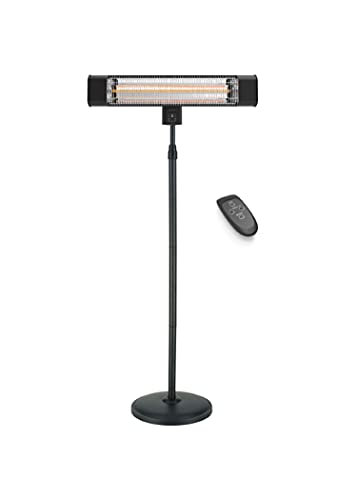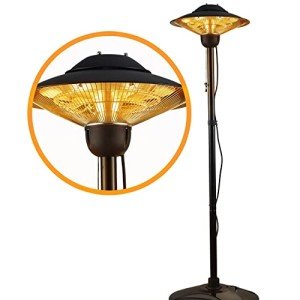It's The Complete Cheat Sheet On Patio Heater Gas Flame
페이지 정보

본문
 The Flame of a Patio Heater Gas Flame
The Flame of a Patio Heater Gas FlameThe flame of a patio heater's gas flame creates an ambient spectacle that's invigorating and mesmerizing at night, especially in darkness. These models are mobile and can be moved around the area you want to heat.
 They can, however, be damaged by winds (check out our guide on how to stop patio heaters from crashing over). Keep a fire extinguisher at your side to prevent any mishaps.
They can, however, be damaged by winds (check out our guide on how to stop patio heaters from crashing over). Keep a fire extinguisher at your side to prevent any mishaps.Warmth
Patio heaters are essential to expanding the outdoor dining and lounge spaces. The halogen flame on the top of the unit creates a focal point that is warm and inviting to guests. Unlike outdoor fire pits that require an open flame and are bound to a single location Patio heaters are mobile and can be moved from table to table when the requirements of a party change.
Some models employ a halogen lamp to produce the flame, while other models use a burner made of metal that burns natural gas as well as liquefied petroleum gases (LPG), propane or butane to heat an infrared reflecting screen that spreads warmth outward. Typically, the screen is silvered to prevent heating the skin and reduce the amount of heat that is lost upwards through conduction. Some models feature a perforated canopy that helps radiate radiant heat and reduce the amount of direct heat.
There are three types of patio heaters that are standing, pedestal and hanging. The latter two are best gas patio heater for large spaces and the former is best suited to smaller spaces under a pergola, trellis or covered porch area. Certain models have an electric ignitor, while others require the pilot light to be lit manually using long matches or a grill lighter. If the pilot light does not stay lit, turn off the unit and try it again within about five minutes. This will stop a gas accumulation that could cause the start of a fire.
Look for a heater equipped with a thermocouple. This device detects the presence or absence of flames and shuts off the propane flow when it isn't detected. This is a crucial safety feature for any gas patio fires (https://www.planetbeer.net/forums/users/dryerwool54) patio heater. You should also make sure your model does not have an open flame. It also comes with a shut off valve that prevents the tank from being empty if the nozzle is disconnected or accidentally shut off.
To avoid tipping, always place your heater on a level surface like bricks or concrete and ensure that it has a weighted base to improve its stability. Always keep a fire extinguisher nearby and apply a soapy solution to the connection points of the gas cylinder regularly to look for leaks. If you smell a foul odor, it could be a sign that your gas cylinder is leaky.
Atmosphere
Patio heaters that feature gas flames not only offer warmth, but also an enchanting glow that enhances the atmosphere and sophistication. In an outdoor bar or restaurant or open workshop, or on the terrace of a hotel room, these tower-style freestanding models are common in both commercial and residential outdoor gas Patio Fires spaces.
Some models have an emitted ceramic fascia, whereas others employ a burner that has a metal reflector to generate light and heat. Certain models come with an automatic tip-over switch that will shut off the gas supply in the event that the unit tip over. Some come with wheels and an area to store propane tanks that are readily available. They are designed to withstand rain, snow, and winds without getting rusty.
These mobile units are a great option for patios with a small space for flooring, since they can be easily fueled by propane tanks. They're relatively affordable to run and provide heat in all directions - ideal for warming multiple tables. They can also be utilized on balconies, decks and poolside areas.
If you own a Michelin-starred restaurant, or a restaurant with a fine dining experience your outdoor patio is as important as your food. These stylish pyramid-shaped patio heaters will add a dash of class to your outdoor dining area.
The yellow or orange flame of a patio heater's gas flame catches the attention of people and can be a striking focal point for social gatherings. If you're hosting an office summer party or a networking event, a few of these eye-catching heating units can help break the ice and turn casual chitchat into cheerful conversation. You can also use them to heat covered outdoor areas to limit the loss of warmth when you close the venue or move in when the sun sets. You can also make use of them to sell vacant patio spaces at your business or event venue, which can make for a great additional source of revenue.
Durability
In contrast to fire pits that burn wood, flame patio heaters do not produce soot or smoke and are safer to use in enclosed spaces such as sunrooms and screened-in porches. They're also more robust than fire pits and have a higher power output over a longer period of. These characteristics make them ideal for restaurants and businesses who wish to utilize their outdoor space the year long.
Choose between electric and propane models. Both models provide constant heat up to five hours per charge. Both models offer a range of appealing design options and safety features, such as the stability of the base and tip-over protection. An electric model is easier to set up and doesn't need a propane tank. Propane models aren't as efficient because you need to store and replace propane tanks. They can provide up to 15 hours of heating from a single propane tank.
The most popular kind of patio heater is one that has a burner that is placed on top of a pole that burns natural gas or liquefied petroleum gas (LPG), or propane, and then is directed by a perforated metal mesh to create the flame effect. Patio heaters with flames produce infrared warmth to warm objects and people nearby. The flames can also create an inviting ambiance to any outdoor space.
Patio heaters come in different sizes and designs, from pyramid-style heaters with faux flames, to practical versions designed to be able to fit under tables. Choose models that are CSA, UL, or ETL certified. They should come with an automatic shutoff and stable bases, as well as a safety feature that stops the flame from shooting over the unit. These models can serve as a focal point on the deck or in a backyard and they can add a dramatic touch to hotel or restaurant terraces.
Propane patio heaters provide the most heat and last for longer. They're also portable and typically have a tank with a weight that ensures they remain in place and is easy to move. Propane heaters are more expensive to run than other kinds of heaters because they use a lot of fuel and are not able to be used in rooms without adequate ventilation.
Safety
Patio heaters are becoming more common at home and in outdoor gas patio heater seating areas in restaurants. These freestanding, gas-fired heaters offer comfort and warmth to patios, terraces, garden areas and porches however, they also pose some dangers to safety. Natural gas and propane burners generate flammable fumes and should be used in well-ventilated spaces. Propane patio heaters must be kept at least three feet away from combustible decorations, furniture or awnings, and must be positioned on a flat, level surface.
The flame of propane patio heaters is visible, which could cause fire in the event that pets or children are too close. The heater should not be left unattended, and children should be kept away from it. Keep a fire extinguisher close by to extinguish any accidental fires. Examine the thermocouple, the pilot tube and orifice for corrosion and any other damage. Watch out for high wind, which can blow the propane patio heater or cause it to fail.
It is essential to follow the manufacturer's instructions and guidelines regarding use and maintenance, regardless of whether you're using a propane patio heater or a natural gas patio heating system. Choose a model with a built-in electronic ignitor which allows lighting the pilot light fast and easy. If you have to manually light your heater, do so only at a safe distance with an extended lighter or gas patio fires match. Choose models that use thermocouples to cut off the propane supply in the event that the flame goes out or is disrupted, such as in the event of a strong wind gust.
Consider a propane patio heater with an inner protected dome, or tempered-glass that completely protects the flame if you have pets or children. This feature reduces the danger of burns from accidental sources and prevents pets and children from being too close to the flame and causing an ignition. Also, keep a fire extinguisher nearby and only use your patio heater in areas that are ventilated particularly during high winds.
- 이전글Guide To Windowdoctor: The Intermediate Guide In Windowdoctor 25.02.19
- 다음글Mini Exercise Bike Tools To Ease Your Daily Life Mini Exercise Bike Trick That Everyone Should Learn 25.02.19
댓글목록
등록된 댓글이 없습니다.




